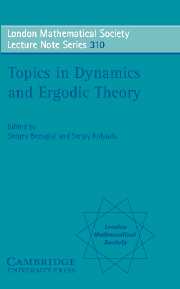Book contents
- Frontmatter
- Contents
- Preface
- Alexeyev's photo
- Introductory talk at the opening of the conference
- Minimal idempotents and ergodic Ramsey theory
- Symbolic dynamics and topological models in dimensions 1 and 2
- Markov odometers
- Geometric proofs of Mather's connecting and accelerating theorems
- Structural stability in one dimensional dynamics
- Periodic points of nonexpansive maps: a survey
- Arithmetic dynamics
- The defect of factor maps and finite equivalence of dynamical systems
- Actions of amenable groups
Minimal idempotents and ergodic Ramsey theory
Published online by Cambridge University Press: 18 August 2009
- Frontmatter
- Contents
- Preface
- Alexeyev's photo
- Introductory talk at the opening of the conference
- Minimal idempotents and ergodic Ramsey theory
- Symbolic dynamics and topological models in dimensions 1 and 2
- Markov odometers
- Geometric proofs of Mather's connecting and accelerating theorems
- Structural stability in one dimensional dynamics
- Periodic points of nonexpansive maps: a survey
- Arithmetic dynamics
- The defect of factor maps and finite equivalence of dynamical systems
- Actions of amenable groups
Summary
INTRODUCTION
What is common between the invertibility of distal maps, partition regularity of diophantine equation x — y = z2, and the notion of mild mixing? The answer is: idempotent ultrafilters, and the goal of this survey is to convince the reader of the unifying role and usefulness of idempotent ultrafilters (and, especially, the minimal ones) in ergodic theory, topological dynamics and Ramsey theory.
We start with reviewing some basic facts about ultrafilters. The reader will find the missing details and more information in the self-contained Section 3 of [B2]. (See also [HiS] for a comprehensive presentation of the material related to topological algebra in the Stone-Čech compactification).
An ultrafilter p on N = {1, 2, …} is, by definition, a maximal filter, namely, a nonempty family of subsets of N satisfying the following conditions (the first three of which constitute the definition of a filter):
Ø ∉ p;
A ∈ p and A ⊂ B imply B ∈ p;
A ∈ p and B ∈ p imply A ∩ B ∈ p;
(maximality) if r ∈ N and N = A1 ∪A2 ∪ … ∪ Ar, then for some i, 1 ≤ i ≤ r, Ai ∈ p.
- Type
- Chapter
- Information
- Topics in Dynamics and Ergodic Theory , pp. 8 - 39Publisher: Cambridge University PressPrint publication year: 2003
- 20
- Cited by



